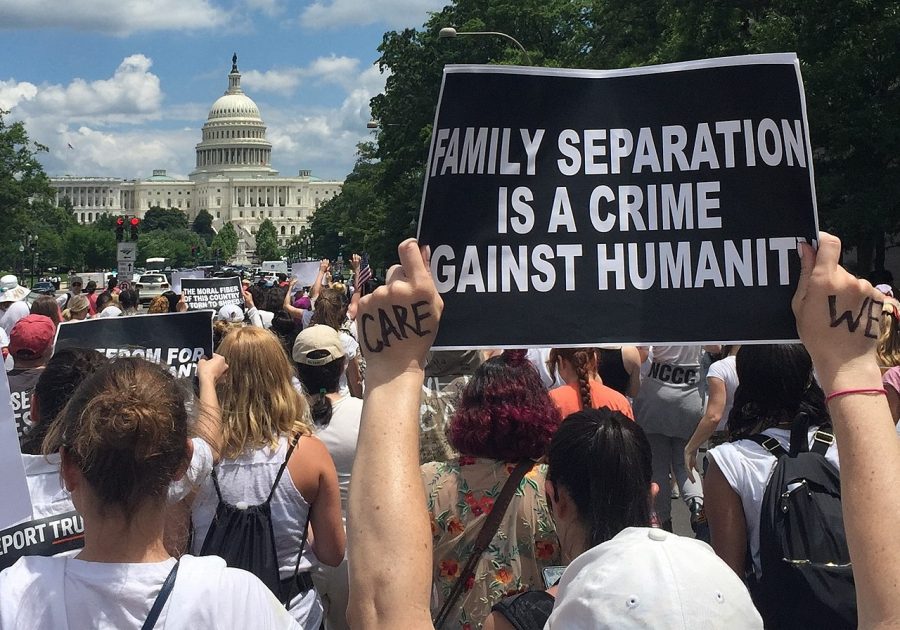Thousands of children separated from parents at US-Mexico border, Biden promises reunification task force
Demonstrators at the June 2018 Women Disobey protest march against the Trump administration’s “zero tolerance” immigration policy in Washington, D.C. (PHOTO COURTESY OF WIKIMEDIA COMMONS)
December 15, 2020
Over 5,500 minors were separated from their parents at the U.S.-Mexico border following the Trump administration’s 2017 immigration crackdown, and the administration cannot locate the parents of 545 children.
The Trump administration implemented its most controversial immigration policy, the “zero tolerance” policy, in 2017. Under this policy, families crossing the border without authorization were targeted and separated as a way to dissuade other asylum-seeking families at the southern border. The separations that took place at the U.S.-Mexico border ended in June 2018 and are among the most heavily disputed humanitarian issues the United States has faced in recent years. In accordance with the “zero tolerance” policy, three things happened to families caught crossing the border without authorization. First, the parents had criminal charges filed against them and were separated from their children. Second, the children were held in shelters while the parents were taken into custody. Finally, the parents were released and then deported back to their home country while the children were sent to live with sponsors, usually relatives or family friends.
“If you cross this border unlawfully, then we will prosecute you,” Attorney General Jeff Sessions said in a 2018 speech. “It’s that simple. If you smuggle illegal aliens across our border, then we will prosecute you. If you are smuggling a child, then we will prosecute you and that child will be separated from you as required by law. If you make false statements to an immigration officer or file a fraudulent asylum claim, that’s a felony. If you help others to do so, that’s a felony, too. You’re going to jail. So if you’re going to come to this country, come here legally. Don’t come here illegally.”
The process of reunifying families after separation has been extremely difficult for various reasons, the first being the current COVID-19 pandemic. In addition, the Trump administration withheld information in regard to the separated families, including names, until the federal courts got involved. As a result, many family reunifications were delayed and made significantly more difficult, as reported by The New York Times. Many parents had either relocated or gone deeper into hiding during the time between their children’s release and the start of the search for parents. They left their homes to escape violence or extortion, so to avoid the dangers, most intentionally withheld information on their whereabouts from even their families when they moved. This left reunification teams without any leads with which to track parents.
When a federal judge and government inspectors found out that the Trump administration had no plan to quickly reunite the separated families, it came to light that the difficulties of reunification has led to some groups giving up on it. The Trump administration argued that most parents avoid the reunification process and want their children to stay in the United States anyway, as reunifying parents with their children involves the child being sent back to their home country, the same place they were trying to leave. In most cases, the families fled their home country because of safety and economic conditions, so leaving their child in the United States feels like the safest option. Many people working with separated families, including American Civil Liberties Union lawyer Lee Gelernt, have reported that families may also avoid reunification because the federal government is complicating the reunification process.
“At some point, we’re going to hit a group of families that becomes very hard to find,” Gelernt said in an interview with The Washington Post. “It’s not inconceivable that we’ll still be looking for them a year from now.”
Joe Biden argued against Donald Trump’s “zero tolerance” policy, stating that it not only hurts the economy—as the U.S. economy’s key sectors rely on immigrants—but also declaring that this policy is “a moral failing and a national shame”. He also explained that the “zero tolerance” policy was the wrong way to go about the immigration issue and plans to do two things as president to fix it. His first plan is to undo the effects of the “zero tolerance” policy by forming a task force dedicated to reuniting the 545 children with their parents. His second plan is to replace the “zero tolerance” policy with a policy that deals with the root cause of the problem and improves the quality of life in Central America.
According to “The Biden Commitment to a Fair and Humane Immigration System”, Biden’s immigration plan detailed on his official website, “Irregular migration from the Northern Triangle countries of Central America cannot be effectively addressed if solutions only focus on our southern border. The better answer lies in addressing the root causes that push desperate people to flee their homes in the first place: violence and insecurity, lack of economic opportunity, and corrupt governance.”



